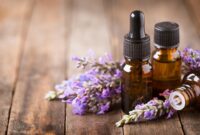Aromatherapy bath oils have gained popularity for their therapeutic benefits, offering a relaxing and rejuvenating experience. These oils are infused with essential oils, which release aromatic compounds that interact with our sense of smell and provide various health benefits.
Whether you’re seeking relaxation, stress relief, or improved sleep, aromatherapy bath oils can enhance your bathing routine and promote overall well-being.
Types of Aromatherapy Bath Oils
Aromatherapy bath oils are a luxurious and therapeutic way to relax and rejuvenate your body and mind. They are made with a blend of essential oils and carrier oils, and each type of oil has its own unique benefits.
There are many different types of aromatherapy bath oils available, each with its own unique blend of essential oils. Some of the most popular essential oils used in aromatherapy bath oils include lavender, chamomile, rosemary, peppermint, and eucalyptus.
Carrier Oils
Carrier oils are used to dilute essential oils and make them safe for use on the skin. Some of the most common carrier oils used in aromatherapy bath oils include jojoba oil, almond oil, and grapeseed oil.
Benefits of Aromatherapy Bath Oils
Indulging in an aromatherapy bath oil experience offers a myriad of therapeutic benefits, enhancing both physical and mental well-being. These aromatic oils, infused with the essence of nature, provide a holistic approach to relaxation, stress relief, and improved sleep quality.
Relaxation and Stress Relief
The soothing aromas of aromatherapy bath oils have a calming effect on the mind and body. They help reduce anxiety and promote relaxation by stimulating the release of endorphins, the body’s natural painkillers. The warm, enveloping bathwater, combined with the aromatic oils, creates a tranquil environment that encourages deep relaxation and eases away stress.
Improved Sleep Quality
Certain aromatherapy bath oils possess sedative properties that can aid in sleep. Oils such as lavender, chamomile, and ylang-ylang promote relaxation and reduce stress, which can contribute to improved sleep quality. By calming the mind and body, these oils help individuals fall asleep more easily and experience a more restful night’s sleep.
How to Use Aromatherapy Bath Oils
Incorporating aromatherapy bath oils into your bathing routine is a simple and effective way to enhance relaxation, soothe the mind and body, and promote overall well-being. Here’s a guide on how to use aromatherapy bath oils:
Optimal Water Temperature
The ideal water temperature for an aromatherapy bath is between 92-98°F (33-37°C). This temperature allows the essential oils to diffuse into the air without evaporating too quickly, maximizing their therapeutic benefits.
Recommended Amount of Bath Oil
The recommended amount of aromatherapy bath oil to use varies depending on the size of your bathtub and the intensity of the desired aroma. Generally, 5-10 drops of essential oil per gallon of water is a good starting point. You can adjust the amount based on your personal preferences and the strength of the essential oil blend.
Precautions and Safety Considerations

Aromatherapy bath oils can be a wonderful way to relax and rejuvenate, but it is important to use them safely. There are a few potential risks and precautions to be aware of before using aromatherapy bath oils.
One of the most important things to do before using aromatherapy bath oils is to perform a skin test. This will help you to determine if you are allergic to any of the ingredients in the oil. To perform a skin test, apply a small amount of the oil to a patch of skin on your inner forearm.
Cover the area with a bandage and wait 24 hours. If you experience any redness, itching, or swelling, do not use the oil.
Pregnant Women and Individuals with Sensitive Skin
Pregnant women and individuals with sensitive skin should be especially cautious when using aromatherapy bath oils. Some essential oils can be harmful to pregnant women and unborn babies. Additionally, people with sensitive skin may be more likely to experience skin irritation from aromatherapy bath oils.
DIY Aromatherapy Bath Oil Recipes

Creating your own aromatherapy bath oils is a simple and rewarding way to enjoy the benefits of essential oils. With just a few ingredients, you can create custom blends that are tailored to your individual needs.
When choosing essential oils for your bath oil, it is important to consider the desired effect. Some oils, such as lavender and chamomile, are known for their relaxing properties, while others, such as peppermint and rosemary, are more energizing. You can also combine different oils to create your own unique blends.
DIY Aromatherapy Bath Oil Recipes
Here are a few DIY aromatherapy bath oil recipes to get you started:
| Purpose | Ingredients | Measurements |
|---|---|---|
| Relaxation |
|
|
| Sleep |
|
|
| Energy |
|
|
To use your aromatherapy bath oil, simply add a few drops to a warm bath. You can also add a carrier oil, such as sweet almond oil or fractionated coconut oil, to help disperse the essential oils throughout the water.
Design an Infographic

An infographic is a powerful tool for visually communicating the benefits of aromatherapy bath oils. By combining compelling imagery, statistics, and facts, you can create an engaging and informative resource that will resonate with your audience.
Creating an Effective Infographic, Aromatherapy bath oils
- Start with a strong headline:Your headline should be concise, attention-grabbing, and accurately reflect the content of your infographic.
- Use visuals effectively:Images, charts, and graphs can help make your infographic more visually appealing and easier to understand.
- Include statistics and data:Facts and figures can add credibility to your infographic and make your points more persuasive.
- Keep it simple:Avoid cluttering your infographic with too much information. Focus on conveying the most important points in a clear and concise way.
- Use a consistent design:The design of your infographic should be consistent throughout, with a統一的色調、字體和整體美學。
Example Infographic
Here is an example of an infographic that visually represents the benefits of aromatherapy bath oils:
- Headline:The Benefits of Aromatherapy Bath Oils
- Image:A photo of a woman relaxing in a bath with aromatherapy oils
- Statistics:
- 90% of people who use aromatherapy bath oils report feeling more relaxed and stress-free.
- 80% of people who use aromatherapy bath oils report sleeping better.
- 70% of people who use aromatherapy bath oils report having less pain and inflammation.
- Call to action:Try aromatherapy bath oils today and experience the benefits for yourself!
Ultimate Conclusion: Aromatherapy Bath Oils

Incorporating aromatherapy bath oils into your bathing routine can transform it into a therapeutic and relaxing experience. By understanding the different types of oils, their benefits, and how to use them safely, you can harness the power of essential oils to promote relaxation, stress relief, and improved sleep.
Essential FAQs
What are the different types of aromatherapy bath oils?
Aromatherapy bath oils come in various types, each with its unique blend of essential oils. Some common types include relaxing oils (e.g., lavender, chamomile), energizing oils (e.g., citrus, peppermint), and sleep-promoting oils (e.g., valerian root, ylang-ylang).
How do I use aromatherapy bath oils?
To use aromatherapy bath oils, add a few drops (typically 5-10) to a warm bath. Disperse the oil by gently swirling the water. Soak for 15-20 minutes, allowing the aromatic compounds to interact with your senses and provide therapeutic benefits.
Are there any safety considerations when using aromatherapy bath oils?
Yes, it’s important to consider safety when using aromatherapy bath oils. Always perform a skin patch test before using any new oil to check for allergic reactions. Avoid using oils if you have sensitive skin or are pregnant. Consult a healthcare professional if you have any concerns.


